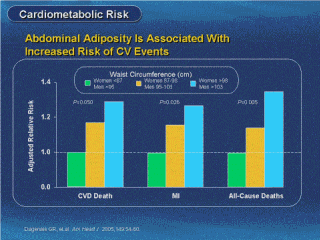| front |1 |2 |3 |4 |5 |6 |7 |8 |9 |10 |11 |12 |13 |14 |15 |16 |17 |18 |19 |20 |21 |22 |23 |24 |25 |26 |27 |28 |29 |30 |31 |32 |33 |34 |35 |36 |review |
 |
The risks of high waist circumference are not
unique to women, nor to persons without a history of heart disease. Data
from Dagenais and colleagues demonstrate that the risk of CVD death, MI, and
all-cause death increase along with waist circumference in 6,620 men and
2,182 women with stable CVD but no congestive heart failure (CHF). The mean
age of subjects was 66 years; they were participants in the Heart Outcomes
Prevention Evaluation (HOPE) study. The primary outcomes of interest were
CVD death, MI, stroke, hospitalization for CHF, and all-cause mortality. The
green bars in this graph represent women and men in the normal waist
circumference range (<87 cm for women, <95 cm for men), the orange bars
represent subjects in the second tertile, or first level of increased waist
circumference. The aqua bars represent individuals in the third tertile, or
group with the highest waist circumferences. The 3 outcomes for which the
increase in relative risk was significant are shown here. The risk of CVD
mortality, MI, and all-cause mortality all rose with the increased waist
circumference. In all-cause mortality, for example, women and men in the
third tertile were found to have a risk of 1.35 relative to individuals in
the normal waist circumference range. The authors concluded that abdominal adiposity worsens the prognosis for individuals with existing CVD; they recommended that weight reduction be added as a component to the therapeutic regimen. Dagenais GR, Yi Q, Mann JF, Bosch J, Pogue J, Yusuf S. Prognostic impact of body weight and abdominal obesity in women and men with cardiovascular disease. Am Heart J. 2005;149:54-60. |